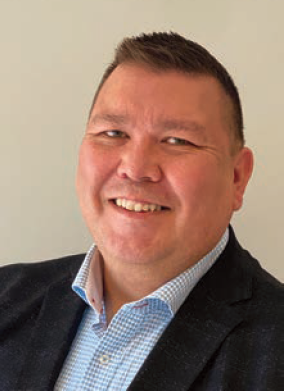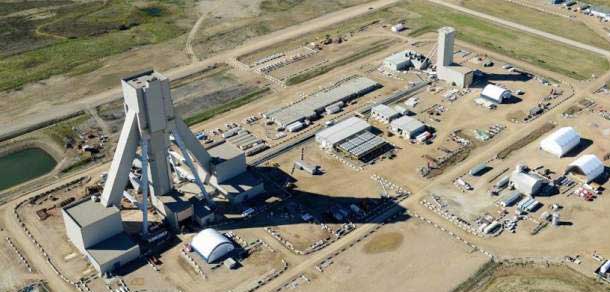
Understanding the Past, Engineering the Future
November 1st, 2021
Rob Martell, P.Eng.
Rob Martell, P.Eng., is now at a point in his career and his life that he is ready to learn more about those who came before him and to prepare others to follow him as he settles into his own space as an Indigenous engineer.
In his role as Principal Mechanical Engineer for BHP, he is contributing to the design of what is expected to be “the largest potash-producing mine in the world.” He has spent more than 20 years preparing for his responsibilities at Jansen S1 today, developing his experience first at Cameco and then Agrium after earning his degree in engineering from the University of Saskatchewan.
During his journey to become an engineer and build his career, he has gradually learned more about his family’s history. Details have trickled out to him about the earlier generations in his family and their experiences with federal legislation and policies.
As he slowly pieces together the past, he is also looking ahead, discovering how he can share his experience, both professional and personal, to encourage others — within the company that employs him as well as the community.
“One thing I’m looking towards is trying to understand my own history and seeing how maybe sharing that story with my colleagues in this company will help them better understand their responsibilities related to truth and reconciliation,” said Martell.
Growing up in Saskatoon, Martell found that he, like many other engineers, has an aptitude for math and science, especially physics. He understood engineering to take a practical, hands-on approach to problem-solving, which appealed to him.
He finished high school around the time that thousands were regaining their legal status as Indians because of Bill C-31. The Assembly of First Nations explains in a fact sheet that this bill amended the Indian Act to eliminate enfranchisement (a legal process that once existed for terminating a person’s Indian status.)
Many who were enfranchised were women and children who lost their status when the women married non-status men. Others lost their status for serving in the Canadian military, going to university, or becoming a priest. However, a person could also apply to be enfranchised. When a man was enfranchised, so, too, were his wife and children. Those who were enfranchised could vote, own property off-reserve and buy alcohol, which, at points in history, had been denied to status Indians. Being enfranchised meant being removed from your band list and losing all associated benefits.
Martell explained what he understands about the story of his father’s family and how it impacted his life. The family lived in rural Saskatchewan on a road allowance near Glaslyn.
They lived on this piece of land because Martell’s great-grandfather gave up his status to receive veterans benefits after returning from the First World War. Martell explains that contributed to the family losing their connection to their band and much of their extended family.
Martell’s grandfather has his own story. He doesn’t know all the details of his grandfather’s early life, but from the pieces shared with him, he understands his grandfather was required to attend residential school even though he did not have status. He eventually ran away from the school with one of his half-brothers.
By the time Martell was ready for university, his father was able to gain status for both of them and the rest of the family. That helped him access the funding he needed to pay for his university education.
As a student, he had opportunities to work for the City of Saskatoon’s engineering department as well as Cameco, flying in to its Key Lake mine on a weekly rotation. That experience gave him the perspective he needed to see what his classes were preparing him for in his career and helped him settle on mechanical engineering.
“I kind of started realizing more about the profession than I learned in school and growing up,” said Martell.
Once he graduated, he had a couple of job offers, but it was the one from Cameco that allowed him to stay in Saskatchewan. There, he was exposed to real-world problems that engineering could address and gained experience with mining equipment used for raiseboring, a mining method used at Cameco’s McArthur River mine, where he spent a lot of time.
He also started to learn about mill processing, developing knowledge he could apply working for his next employer, Agrium, as a project engineer. First, he learned about maintenance, which meant understanding how operators were using the equipment and ensuring it could continue to perform the job required of it. That led to working on improvements, such as addressing bottlenecks in the processing of the resource. Working on improvements allowed him to develop his knowledge on capital projects process, which eventually led to a position as a lead for project systems integration and support.
This experience led him to being part of a major capital project – the expansion of Vanscoy mine known as Project VAULT.
“It was good to be part of that project and to see it from the concept of the project and what they’re trying to do to get to the ultimate capacity and designing right through all of the phases,” said Martell.
“I was lucky enough to start early on in the project — I’d say (from) like one of the earlier concepts — and saw right through all the engineering, construction and commissioning, start-up and was involved in optimization. Kind of getting things to run the way that we intended them to run since I was involved in the design.”
Moving to BHP has allowed him to work on another major capital project — the Jansen S1 project near Lanigan. BHP announced in August that it had approved spending $7.5 billion to complete the project.
“My role is primarily acting as an owner’s engineer within the mechanical field,” said Martell.
“The role is mainly an auditing role. We don’t essentially do the engineering, but we make sure that we’re seeing that all of our key value drivers are in the design and we maintain the value that we’d like to see in this project.”
Production levels, operating costs and minimizing downtime are all factors he must consider when executing his responsibilities today, but he foresees his role changing over time, just as it did when he was at Agrium.
“In supporting the design through execution, I’ll probably eventually work into some sort of operations role that will actually be maintaining the value of the asset being developed,” said Martell.
He would advise young engineers to seek to work with companies whose purpose and actions align with their own values. He appreciates what it means to work for a resources company that is providing the world the resources it needs for energy and food production.
“The BHP purpose is essentially to bring people and resources together to build a better world, which is something I feel strongly about,” said Martell.
It is also important to him that his supervisor at BHP is encouraging him to connect with his heritage and find his own way of including it in his professional identity and purpose at this point in his career.
“It’s actually in my key performance indicators for the year, so it’s part of my development plan to be able to do that because I expressed my interest in it,” said Martell.
Joining the Saskatchewan Professional Chapter of the Canadian Indigenous Science and Engineering Society (.caISES) gave him perspective on his career. .caISES describes itself as “a forum to come together to network, to give and receive professional development, to offer fellowship with individuals with similar goals, dreams, and expertise.”
He is interested in encouraging Indigenous students’ interest in science, technology, engineering and math (STEM), but wants to do it in his own way.
“I would say there are not a lot of Indigenous engineers out there who, at least, identify or even network in the profession.”
“A lot of Indigenous people who are in engineering or STEM are pushed into promoting STEM and into more about management and policy development in government relations-type roles.
“I find myself a rarity in that group. I’m still technical and work heavily technical and I kind of still want to work in technical while looking for opportunities to work on (promoting STEM.)”
He sees how Indigenous engagement is a global matter because of his work for BHP, which is headquartered in Australia with operations there as well as Chile, the U.S. and Canada – all of which have an Indigenous population. He has noticed through his interactions with global colleagues this level of understanding within the company.
He is part of a truth and reconciliation committee at BHP. As Canadians take in the news of unmarked graves being identified this year at residential school sites, he sees how people are growing in their willingness to look at the truth of the past. As painful memories are brought up for some Indigenous people, Martell sees those who recognize the need to take responsibility today to address systemic racism created by previous generations’ actions and decisions.
“It had always had been there but we didn’t talk about it right,” said Martell.
Sharing and receiving truth is vulnerable. He considers that perhaps because many more Canadians are showing interest in and acceptance of the past, some Indigenous people, like his father and other family members, are somewhat more comfortable revealing additional details about the family’s history.
There is also the fact that he and they are aging. They may feel more prepared to share and for him to receive more of the truth at this point in their lives.
“This committee that I’ve just joined, it’s interesting to see how there is this relationship and that it’s not just them being ‘We’re here now and just tell us what to do.’
It’s like, ‘Well, what is our part?’ and taking responsibility from that side.”
